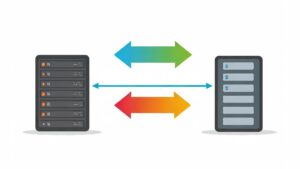Agile project management has taken center stage in modern software development and beyond, revolutionizing the way teams work, deliver, and collaborate. Agile is a set of principles that helps teams be more responsive, adaptive, and efficient. It enables them to focus on customer needs while iterating rapidly to deliver high-quality outcomes.
In this article, we’ll take a deep dive into Agile project management, breaking down everything you need to know—from the basics to advanced concepts. By the end, you’ll have a solid understanding of Agile practices, tools, and techniques that will help you implement and master Agile in your projects.
1. Introduction to Agile Project Management
Agile project management is an iterative approach to planning and guiding project processes. Just as in Agile software development, an Agile project is completed in small sections or “iterations.” In contrast to traditional project management methods that focus on delivering a project in one single release, Agile encourages continuous delivery of functional parts of the project at regular intervals. This provides many benefits, including flexibility, improved quality, and frequent delivery of value to the customer.
Key Characteristics of Agile:
- Customer-centric: Focused on delivering high-quality products that meet customer needs.
- Incremental: Work is done in smaller increments rather than in one large batch.
- Collaborative: Strong emphasis on collaboration among team members and stakeholders.
- Adaptive: Flexible and open to changes throughout the project lifecycle.
- Feedback-driven: Continuous feedback loops ensure the project is moving in the right direction.
2. The History and Evolution of Agile
Agile was born out of the need to address the limitations of traditional project management methodologies, specifically the Waterfall method. In the late 1990s, the software development industry was facing frequent failures due to rigid processes, delayed deliveries, and inability to adapt to change. Developers, tired of these inefficiencies, sought a new way of managing projects.
In 2001, a group of software developers created the Agile Manifesto, which laid the foundation for modern Agile methodologies. Since then, Agile has evolved and expanded, finding application in not only software development but also marketing, product development, and other industries.
3. Key Principles of Agile
Agile project management is based on a set of core principles, designed to promote adaptability, collaboration, and continuous improvement. These principles are outlined in the Agile Manifesto:
- Customer satisfaction through early and continuous delivery of valuable software.
- Welcome changing requirements, even late in development. Agile processes harness change for the customer’s competitive advantage.
- Deliver working software frequently, from a couple of weeks to a couple of months, with a preference for the shorter timescale.
- Business people and developers must work together daily throughout the project.
- Build projects around motivated individuals. Give them the environment and support they need, and trust them to get the job done.
- Face-to-face conversation is the most efficient and effective method of conveying information to and within a development team.
- Working software is the primary measure of progress.
- Agile processes promote sustainable development. The sponsors, developers, and users should be able to maintain a constant pace indefinitely.
- Continuous attention to technical excellence and good design enhances agility.
- Simplicity—the art of maximizing the amount of work not done—is essential.
- The best architectures, requirements, and designs emerge from self-organizing teams.
- At regular intervals, the team reflects on how to become more effective, then tunes and adjusts its behavior accordingly.
4. The Agile Manifesto and Its Core Values
The Agile Manifesto defines the philosophy of Agile, consisting of four core values:
- Individuals and interactions over processes and tools: This emphasizes the importance of collaboration and communication over sticking rigidly to tools and predefined processes.
- Working software over comprehensive documentation: Instead of spending too much time on documentation, Agile encourages creating functional products early and improving them through feedback.
- Customer collaboration over contract negotiation: Agile focuses on working closely with customers to adjust to their evolving needs rather than adhering strictly to contract terms.
- Responding to change over following a plan: Agile is flexible, allowing teams to adapt to new information and changing project requirements.
5. Agile Methodologies
Agile project management isn’t a one-size-fits-all approach. Several methodologies fall under the Agile umbrella, each with its own practices and focus areas.
Scrum
Scrum is the most popular Agile framework. It involves working in sprints, which are time-boxed iterations (typically 2-4 weeks). A Scrum team typically consists of a Product Owner, a Scrum Master, and Development Team members.
- Product Backlog: A prioritized list of tasks and features.
- Sprint Planning: A meeting where the team plans tasks for the upcoming sprint.
- Daily Stand-up: A short meeting to discuss progress, roadblocks, and next steps.
- Sprint Review and Retrospective: Review the work done, gather feedback, and improve processes.
Kanban
Kanban focuses on visualizing work, limiting work-in-progress (WIP), and optimizing flow. It uses a Kanban Board to represent the various stages of the workflow, such as To Do, In Progress, and Done.
- WIP limits ensure that the team isn’t overloaded with tasks.
- It allows continuous delivery without time-boxed iterations.
Lean
Lean focuses on eliminating waste and maximizing value. Originating from the manufacturing industry, Lean emphasizes efficiency and minimizing anything that does not add value to the customer.
Extreme Programming (XP)
Extreme Programming (XP) is a methodology that emphasizes technical excellence and frequent releases. It includes practices such as pair programming, test-driven development, and continuous integration.
6. The Agile Project Life Cycle
Agile projects follow a flexible lifecycle with overlapping phases. The typical stages in Agile include:
- Concept: Identify and document the initial idea.
- Inception: Create a product backlog, assign team roles, and define initial requirements.
- Iteration: Develop and deliver functional increments of the product through iterations (sprints).
- Release: Prepare the product for release to customers.
- Maintenance: Ongoing improvement, fixing defects, and adapting to user feedback.
- Retirement: Decommission the product when it is no longer useful.
7. Agile Roles and Responsibilities
Agile relies on well-defined roles to ensure smooth operation. Key roles include:
- Product Owner: Responsible for maximizing product value by managing the product backlog.
- Scrum Master: Ensures the team follows Agile practices and removes any impediments to progress.
- Development Team: A cross-functional team responsible for delivering potentially shippable product increments at the end of each sprint.
8. Agile Ceremonies and Events
Sprint Planning
The team defines the work to be done during the sprint. They decide on which backlog items to tackle and how to accomplish them.
Daily Stand-up (Daily Scrum)
A 15-minute meeting where team members discuss what they worked on, what they plan to work on, and any roadblocks.
Sprint Review
Held at the end of the sprint, this is where the team demonstrates completed work to stakeholders and gathers feedback.
Sprint Retrospective
After the Sprint Review, the team reflects on the sprint and discusses what went well, what didn’t, and how to improve.
9. Agile Tools and Artifacts
Several artifacts and tools support Agile methodologies:
- User Stories: Short, simple descriptions of a feature told from the perspective of the user.
- Product Backlog: A prioritized list of user stories and tasks.
- Burndown Charts: A visual representation of work completed versus time remaining.
- Definition of Done: Criteria that must be met for work to be considered complete.
- Definition of Ready: Criteria that a user story must meet before it is ready to be worked on.
10. Key Metrics in Agile
Velocity
Measures the amount of work completed during a sprint. It helps predict how much work can be done in future sprints.
Cycle Time
Measures the time it takes for a task to move from the start of the workflow to completion.
Burnup/Burndown Charts
Visual representations of the amount of work completed versus the remaining tasks.
11. Benefits of Agile Project Management
- Faster time to market: Agile promotes continuous delivery, enabling teams to release functional parts of the product early.
- Increased flexibility: Teams can adapt to changes in requirements, ensuring they always meet the current needs of the customer.
- Improved customer satisfaction: Regular customer feedback ensures that the product aligns with customer needs.
- Higher product quality: Agile focuses on continuous testing and iterative improvements.
- Increased team collaboration and morale: Agile emphasizes open communication, reducing silos and empowering teams to work more collaboratively.
12. Common Challenges and How to Overcome Them
Agile adoption can face hurdles, such as:
- Resistance to change: Agile requires a cultural shift, and not everyone may be willing to embrace it.
- Lack of team experience: Agile practices require specific skills, and inexperienced teams may struggle initially.
- Miscommunication with stakeholders: Continuous collaboration with stakeholders is crucial. Misalignment can cause delays or scope creep.
13. Agile Best Practices
- Keep the backlog prioritized: A constantly updated backlog ensures the team works on the highest-value items.
- Regular retrospectives: Continuous improvement is at the heart of Agile. Frequent retrospectives help identify areas of improvement.
- Limit work in progress (WIP): This ensures that the team focuses on completing tasks before starting new ones, reducing multitasking and bottlenecks.
- Continuous integration and testing: Frequent testing ensures bugs are caught early, making it easier to resolve issues.
14. Scaling Agile in Large Organizations
For large organizations, scaling Agile can be challenging. Frameworks like SAFe (Scaled Agile Framework), LeSS (Large-Scale Scrum), and DA (Disciplined Agile) offer strategies to help apply Agile across multiple teams and departments.
15. Agile vs Traditional Project Management (Waterfall)
In traditional project management, such as Waterfall, projects follow a linear sequence of phases (e.g., planning, design, implementation). This method is rigid and doesn’t handle changes well.
Agile, on the other hand, is more flexible and iterative. It focuses on continuous delivery, customer feedback, and being open to change.
Key Differences:
- Flexibility: Agile is more flexible, allowing changes throughout the project.
- Customer involvement: Agile involves the customer at every stage of the project.
- Delivery: Agile delivers in iterations, whereas Waterfall delivers the complete product at the end.
16. Becoming an Agile Expert
To become an Agile expert, consider the following steps:
- Master Agile Methodologies: Start by learning the foundational frameworks such as Scrum, Kanban, and Lean.
- Get Certified: Consider Agile certifications such as Certified Scrum Master (CSM), Certified Agile Project Manager (PMI-ACP), or Scaled Agile Framework (SAFe) certification.
- Work on Agile Projects: The best way to learn Agile is by applying it. Join or lead Agile teams to get hands-on experience.
- Stay Updated: Agile continues to evolve. Stay updated on the latest trends, tools, and best practices by reading articles, attending conferences, and participating in Agile communities.
By mastering Agile project management, you can drive faster delivery, increase customer satisfaction, and improve team collaboration. With its iterative and flexible approach, Agile enables teams to focus on delivering value while continuously improving their processes. Whether you’re just starting or looking to scale Agile practices across your organization, this guide provides the foundational knowledge to become an Agile expert.












